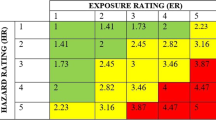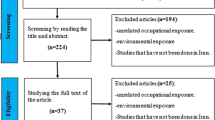Abstract
Occupational exposure to contaminants created by electronic manufacturing process is not well characterized. The aim of this study was to carry out risk assessments of exposure to welding fume and airborne heavy metals (HMs) in electronic manufacturing workshops. Seventy-six air samples were collected from five sites in Hangzhou, China. In welding workshops, the most abundant contaminant found was welding fume, followed by Fe, Mn, Zn, Cu, Pb, Cd, and Cr. The concentration of Mn was positively correlated with Fe (r = 0.906). When compared with non-welding workshops, the Fe content in the air of welding workshops increased significantly (P < 0.05), while the Cu content decreased significantly (P < 0.05). Singapore semi-quantitative health risk assessment model and the United States Environmental Protection Agency (US EPA) inhalation risk assessment model were applied to assess the occupational exposure. In welding workshops, the levels of 8-h time weighted average (8 h-TWA) calculated for welding fume (range 0.288 ~ 6.281 mg/m3), Mn (range Nd ~ 0.829 mg/m3), and Fe (range 0.027 ~ 2.234 mg/m3) partly exceeded the permissible limits. While, in non-welding workshops, the average of 8 h-TWA for Cu (0.411 mg/m3) was higher than the limit. The risk rates (RR) assessed for Pb (2.4 vs 1.7), Mn (2.0 vs 1.4), and Fe (1.4 vs 1.0) were higher in welding workshops than that in non-welding workshops, but Cu (1.0 vs 2.2) were lower. The mean excess lifetime cancer risks (ELCR) in welding (5.59E − 06 per 1000 people) and non-welding (1.88E − 06 per 1000 people) workshops were acceptable. The mean non-cancer risk (HQ) estimated for Mn was greater than 10 in both welding (HQ = 164) and non-welding (HQ = 11.1) workshops. These results indicate that there was a risk of occupational exposure implication in the electronic manufacturing workshops. Reducing contaminant exposure through engineering controls and management strategies, such as efficient ventilation and reducing exposure hours, is thus suggested.


Similar content being viewed by others
Data availability
The datasets used in this study are available from the corresponding author on reasonable request.
References
Alici NS, Öziş TN, Çeliker G et al (2022) Welder’s lung and brain MRI findings in manganese-exposed welders. Med Lav 113(6):e2022049
Anthony JS, Zamel N, Aberman A (1978) Abnormalities in pulmonary function after brief exposure to toxic metal fumes. Can Med Assoc J 119(6):586–588
Antonini JM (2003) Health effects of welding. Crit Rev Toxicol 33(1):61–103. https://doi.org/10.1080/713611032
Antonini JM, Taylor MD, Zimmer AT et al (2004) Pulmonary responses to welding fumes: role of metal constituents. J Toxicol Environ Health A 67(3):233–249. https://doi.org/10.1080/15287390490266909
Balkhyour MA, Goknil MK (2010) Total fume and metal concentrations during welding in selected factories in Jeddah, Saudi Arabia. Int J Environ Res Public Health 7(7):2978–2987. https://doi.org/10.3390/ijerph7072978
Beach JR, Dennis JH, Avery AJ et al (1996) An epidemiologic investigation of asthma in welders. Am J Respir Crit Care Med 154(5):1394–1400. https://doi.org/10.1164/ajrccm.154.5.8912754
Coggon D, Inskip H, Winter P et al (1994) Lobar pneumonia: an occupational disease in welders. Lancet 344(8914):41–43. https://doi.org/10.1016/s0140-6736(94)91056-1
Dehghani F, Omidi F, Fallahzadeh RA et al (2021) Health risk assessment of occupational exposure to heavy metals in a steel casting unit of a steelmaking plant using Monte-Carlo simulation technique. Toxicol Ind Health 37(7):431–440. https://doi.org/10.1177/07482337211019593
Dueck ME, Rafiee A, Mino J et al (2021) Welding fume exposure and health risk assessment in a cohort of apprentice welders. Ann Work Expo Health 65(7):775–788. https://doi.org/10.1093/annweh/wxab016
Ellingsen DG, Dubeikovskaya L, Dahl K et al (2006) Air exposure assessment and biological monitoring of manganese and other major welding fume components in welders. J Environ Monit 8(10):1078–1086. https://doi.org/10.1039/b605549d
US EPA (2009) Risk assessment guidance for superfund, volume I: human health evaluation manual (part f, supplemental guidance for inhalation risk assessment). Office of Superfund Remediation and Technology Innovation Environmental Protection Agency, Washington, DC. https://www.epa.gov/risk/risk-assessment-guidance-superfund-rags-part-f
Flynn MR, Susi P (2010) Manganese, iron, and total particulate exposures to welders. J Occup Environ Hyg 7(2):115–126. https://doi.org/10.1080/15459620903454600
Golbabaei F, Seyedsomea M, Ghahri A et al (2012) Assessment of welders exposure to carcinogen metals from manual metal arc welding in gas transmission pipelines, iran. Iran J Public Health 41(8):61–70
Guha N, Loomis D, Guyton KZ et al (2017) Carcinogenicity of welding, molybdenum trioxide, and indium tin oxide. Lancet Oncol 18(5):581–582. https://doi.org/10.1016/S1470-2045(17)30255-3
Haase LM, Birk T, Poland CA et al (2022) Cross-sectional study of workers employed at a copper smelter—effects of long-term exposures to copper on lung function and chronic inflammation. J Occup Environ Med 64(9):e550-558. https://doi.org/10.1097/JOM.0000000000002610
Hariri A, Paiman NA, Leman AM et al (2014) Development of welding fumes health index (WFHI) for welding workplace’s safety and health assessment. Iran J Public Health 43(8):1045–1059
Hariri A, Noor NM, Paiman NA et al (2018) Heavy metals found in the breathing zone, toenails and lung function of welders working in an air-conditioned welding workplace. Int J Occup Saf Ergon 24(4):646–651. https://doi.org/10.1080/10803548.2017.1368950
Hassani H, Golbabaei F, Ghahri A et al (2012) Occupational exposure to manganese-containing welding fumes and pulmonary function indices among natural gas transmission pipeline welders. J Occup Health 54(4):316–322. https://doi.org/10.1539/joh.11-0269-fs
Hedmer M, Karlsson J, Andersson U et al (2014) Exposure to respirable dust and manganese and prevalence of airways symptoms, among Swedish mild steel welders in the manufacturing industry. Int Arch Occup Environ Health 87(6):623–634. https://doi.org/10.1007/s00420-013-0896-3
Heibati B, Pollitt KJG, Karimi A et al (2017) BTEX exposure assessment and quantitative risk assessment among petroleum product distributors. Ecotoxicol Environ Saf 144:445–449. https://doi.org/10.1016/j.ecoenv.2017.06.055
Insley AL, Maskrey JR, Hallett LA et al (2019) Occupational survey of airborne metal exposures to welders, metalworkers, and bystanders in small fabrication shops. J Occup Environ Hyg 16(6):410–421. https://doi.org/10.1080/15459624.2019.1603389
Karkoszka T, Soković M (2012) Integrated risk estimation of metal inert gas (MIG) and metal active gas (MAG) welding processes. Metalurgija 51(2):179–182
Karrari P, Mehrpour O, Abdollahi M (2012) A systematic review on status of lead pollution and toxicity in Iran: guidance for preventive measures. Daru 20(1):2. https://doi.org/10.1186/1560-8115-20-2
Kent MS, Corbett ML, Glavin M (2007) Characterization and analysis of airborne metal exposures among workers recycling cellular Phones. IEEE International Symposium on Electronics and the Environment, Orlando, pp 112–116. https://www.researchgate.net/publication/4251599_Characterization_and_Analysis_of_Airborne_Metal_Exposures_among_Workers_Recycling_Cellular_Phones
Lau WKY, Liang P, Man YB et al (2014) Human health risk assessment based on trace metals in suspended air particulates, surface dust, and floor dust from e-waste recycling workshops in Hong Kong. China Environ Sci Pollut Res Int 21(5):3813–3825. https://doi.org/10.1007/s11356-013-2372-8
Leman AM, Yusof MZM, Omar AR et al (2010) Environmental quality index (EQI) for industrial ventilation and occupational safety and health evaluation in manufacturing plant. Asian Journal on Quality 11(3):210–222. https://doi.org/10.1108/15982681011093970
Leung AOW, Duzgoren-Aydin NS, Cheung KC et al (2008) Heavy metals concentrations of surface dust from e-waste recycling and its human health implications in southeast China. Environ Sci Technol 42(7):2674–2680. https://doi.org/10.1021/es071873x
Li GJ, Zhang L, Lu L et al (2004) Occupational exposure to welding fume among welders: alterations of manganese, iron, zinc, copper, and lead in body fluids and the oxidative stress status. J Occup Environ Med 46(3):241–248. https://doi.org/10.1097/01.jom.0000116900.49159.03
Mansouri N, Atbi F, Moharamnezhad N et al (2008) Gravimetric and analytical evaluation of welding fume in an automobile part manufacturing factory. J Res Health Sci 8(2):1–8
Mocevic E, Kristiansen P, Bonde JP (2015) Risk of ischemic heart disease following occupational exposure to welding fumes: a systematic review with meta-analysis. Int Arch Occup Environ Health 88(3):259–272. https://doi.org/10.1007/s00420-014-0965-2
Mohammadyan M, Moosazadeh M, Borji A et al (2019) Exposure to lead and its effect on sleep quality and digestive problems in soldering workers. Environ Monit Assess 191(3):184. https://doi.org/10.1007/s10661-019-7298-2
Mohammadyan M, Moosazadeh M, Khanjani N et al (2019) Quantitative and semi-quantitative risk assessment of occupational exposure to lead among electrical solderers in Neyshabur. Iran Environ Sci Pollut Res Int 26(30):31207–31214. https://doi.org/10.1007/s11356-019-06220-9
Ohshiro H, Nose T, Sugiyama K et al (1988) A case study of acute cadmium poisoning by welding work. Sangyo Igaku 30(3):210–211
Park RM, Schulte PA, Bowman JD et al (2005) Potential occupational risks for neurodegenerative diseases. Am J Ind Med 48(1):63–77. https://doi.org/10.1002/ajim.20178
Pesch B, Weiss T, Kendzia B et al (2012) Levels and predictors of airborne and internal exposure to manganese and iron among welders. J Expo Sci Environ Epidemiol 22(3):291–298. https://doi.org/10.1038/jes.2012.9
Racette BA, McGee-Minnich L, Moerlein SM et al (2001) Welding-related parkinsonism: clinical features, treatment, and pathophysiology. Neurology 56(1):8–13. https://doi.org/10.1212/wnl.56.1.8
Racette BA, Tabbal SD, Jennings D et al (2005) Prevalence of parkinsonism and relationship to exposure in a large sample of Alabama welders. Neurology 64(2):230–235. https://doi.org/10.1212/01.WNL.0000149511.19487.44
Riccelli MG, Goldoni M, Poli D et al (2020) Welding fumes, a risk factor for lung diseases. Int J Environ Res Public Health 17(7):2552. https://doi.org/10.3390/ijerph17072552
Riederer P, Reichmann H, Janetzky B et al (2001) Neural degeneration in Parkinson’s disease. Adv Neurol 86:125–136
Sferlazza SJ, Beckett WS (1991) The respiratory health of welders. Am Rev Respir Dis 143(5 Pt 1):1134–1148. https://doi.org/10.1164/ajrccm/143.5_Pt_1.1134
Smargiassi A, Baldwin M, Savard S et al (2000) Assessment of exposure to manganese in welding operations during the assembly of heavy excavation machinery accessories. Appl Occup Environ Hyg 15(10):746–750. https://doi.org/10.1080/10473220050129383
Yang SY, Lin JM, Lin WY et al (2018) Cancer risk assessment for occupational exposure to chromium and nickel in welding fumes from pipeline construction, pressure container manufacturing, and shipyard building in Taiwan. J Occup Health 60(6):515–524. https://doi.org/10.1539/joh.2018-0075-FS
Yeo SH, Neo KG (1998) Inclusion of environmental performance for decision making of welding processes. J Mater Process Technol 82:78–88. https://doi.org/10.1016/S0924-0136(98)00022-3
Zimmer AT, Biswas P (2001) Characterization of the aerosols resulting from arc welding processes. J Aerosol Sci 32(8):993–1008. https://doi.org/10.1016/S0021-8502(01)00035-0
Funding
This work was supported by the Hangzhou Municipal Health Commission (Grant no. A20210491).
Author information
Authors and Affiliations
Contributions
Z. L.: study design, writing original draft. J. Y.: sample collection. X. S.: chemical analysis. J. S.: methodology. H. Y.: methodology. All authors have read and agreed to the final version of the manuscript.
Corresponding author
Ethics declarations
Ethical approval
Not applicable.
Consent to participate
Not applicable. The study did not involve human participants.
Consent for publication
All authors declare they have given consent to publish this article.
Competing interests
The authors declare no competing interests.
Additional information
Responsible Editor: Lotfi Aleya
Publisher's note
Springer Nature remains neutral with regard to jurisdictional claims in published maps and institutional affiliations.
Supplementary Information
Below is the link to the electronic supplementary material.
Rights and permissions
Springer Nature or its licensor (e.g. a society or other partner) holds exclusive rights to this article under a publishing agreement with the author(s) or other rightsholder(s); author self-archiving of the accepted manuscript version of this article is solely governed by the terms of such publishing agreement and applicable law.
About this article
Cite this article
Zhang, L., Yu, JM., Shan, XY. et al. Characterization of welding fume and airborne heavy metals in electronic manufacturing workshops in Hangzhou, China: implication for occupational population exposure. Environ Sci Pollut Res 30, 57398–57409 (2023). https://doi.org/10.1007/s11356-023-26569-2
Received:
Accepted:
Published:
Issue Date:
DOI: https://doi.org/10.1007/s11356-023-26569-2




